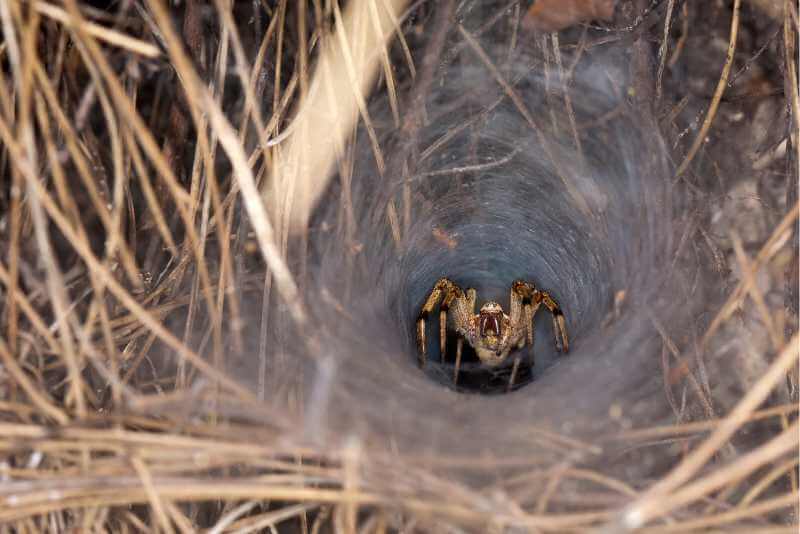Do Wolf Spiders Build Webs? Spiders have long been a source of fascination and fear for many people, leading to numerous misconceptions about their behavior and abilities. One such myth revolves around whether or not wolf spiders build webs.
The short answer is no, wolf spiders do not build webs to catch their prey. However, they do use silk for other purposes.
Why Don’t Wolf Spiders Make Webs?
The primary reason wolf spiders don’t make webs is due to their unique hunting strategies and adaptations. Instead of relying on webs to capture prey, as other spiders do, these wolf spiders have a unique way of catching their prey.
To give you an idea here are some key factors to why web-building is not really necessary for wolf spiders!
Their Hunting Techniques
Wolf spiders actively stalk and pursue their prey, much like wolves, which is where they get their name they wolf spider. They use their keen senses, speed, and stealth to locate and capture prey, usually, insects, small spiders, and other invertebrates.
This active hunting strategy eliminates the need for constructing webs, as they directly engage with their prey in various habitats such as grasslands, forests, and wetlands.
Exceptional Eyesight
Unlike many web-building spiders that primarily rely on vibrations and touch to detect their prey, wolf spiders have remarkable eyesight. They possess two large, forward-facing eyes and six smaller eyes arranged in a semicircle, providing them with a wide field of vision.
This keen eyesight enables them to actively hunt, spot potential prey, and avoid potential threats without the need for a web.
Agility And Speed
Wolf spiders are known for their agility and speed, which are crucial components of their hunting strategy. They can quickly move through different terrains, using their robust bodies and long, spiny legs to navigate their environment effectively.
This ability to swiftly approach and subdue their prey further negates the need for web-building.

Alternative Uses Of Silk By Wolf Spiders
While wolf spiders do not use silk to build webs for capturing prey, they still utilize silk for other purposes.
- Egg Sac Protection and Parental Care: Female wolf spiders spin a silken sac to protect their eggs, which they carry around on their abdomen until the spiderlings hatch. Once hatched, the spiderlings climb onto their mother’s back and stay there for a short period before dispersing to establish their own territories.
- Burrow Construction and Lining: Wolf spiders also use silk to create shelters for themselves. They often dig burrows in the ground, lining the walls with silk to reinforce the structure and provide a comfortable resting place.
- Trapdoor Creation for Hiding and Ambush: Some species even spin a silk “trapdoor” to cover the entrance of their burrow, allowing them to remain hidden from predators and potential prey.
Other Spider Species That Don’t Make Webs?
There are several other spider species that, like wolf spiders, do not build webs to catch their prey. These spiders have evolved different hunting techniques and adaptations that make web-building unnecessary. Some of these species include:
Jumping spiders (family Salticidae):
Jumping spiders are known for their incredible jumping abilities and excellent eyesight. Like the wolf spider, They are also a species of spider that doesn’t make webs and will rather hunt and stalk their prey. With over 6,000 species, jumping spiders are one of the most diverse spiders.
Fishing spiders (family Pisauridae):
Fishing spiders, also known as nursery web spiders, are semi-aquatic hunters that typically live near water. They primarily rely on their speed and ambush tactics to capture prey, which can include insects, small fish, and aquatic invertebrates. Female fishing spiders build a protective nursery web for their egg sac but do not use it for catching prey.
Lynx spiders (family Oxyopidae):
Lynx spiders are agile hunters who use their speed and powerful legs to chase and pounce on their prey. They are often found in vegetation, where they wait to ambush passing insects. Lynx spiders do not build webs; instead, they rely on their keen eyesight and hunting abilities to catch their food.
Crab spiders (family Thomisidae):
Crab spiders are named after their crab-like appearance and movement. They are ambush predators that use camouflage to blend in with flowers or leaves, patiently waiting for their prey to come close. Once within range, they quickly grab and subdue their victim. Crab spiders do not build webs to capture prey.
Huntsman spiders (family Sparassidae):
Huntsman spiders are large, fast-moving spiders that actively hunt and chase their prey. They have excellent eyesight and rely on their speed and agility to capture insects, small spiders, and other invertebrates. Huntsman spiders do not build webs but may use silk to create egg sacs or retreats.
These non-web-building spider species showcase the incredible diversity and adaptability of arachnids, each with their unique hunting strategies and adaptations that make web-building unnecessary.
Conclusion
While it’s a common misconception that all spiders build webs, as you’ve just read this is not the case for wolf spiders. They mainly rely on stealth and agility to catch prey, rather than constructing intricate webs.



